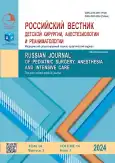CD10和CD16中性粒细胞作为新生儿全身性感染发展的标志物
- 作者: Obraztsov I.V.1, Obraztsova A.A.1, Voronina O.V.1, Chernikova E.A.1, Mishchenko A.Y.1, Gordukova M.A.1, Davydova N.V.1, Zhirkova J.V.1,2, Korsunskiy A.A.1,3
-
隶属关系:
- Speransky Children’s City Clinical Hospital No. 9
- Pirogov Russian National Research Medical University
- Sechenov First Moscow State Medical University
- 期: 卷 14, 编号 3 (2024)
- 页面: 369-380
- 栏目: Original Study Articles
- URL: https://ogarev-online.ru/2219-4061/article/view/268211
- DOI: https://doi.org/10.17816/psaic1822
- ID: 268211
如何引用文章
全文:
详细
现实性。新生儿脓毒症的问题至今仍然十分重要,因此寻找新的早期预测因子以识别感染的发展和扩散具有重要意义。
目的。确定在新生儿感染过程中具有预后价值的中性粒细胞表型特征。
材料和方法。在本研究中,进行了一项观察性单中心前瞻性选择性非对照实验,研究对象为261名新生儿,时间范围为2022年至2023年,分为“对照”组(n = 96)、 “局部感染”组(n = 95)和“全身感染”组(n = 70)。调查对象的平均后概念年龄为38.7周(范围38.4–39.0周),妊娠周数为38.0周(范围37.7–38.2周)。在住院的第一天,从外周静脉采集血样以进行分析。
结果。CD16水平的降低与重症监护(ОРИТ)治疗时间的延长相关,从4天增加到8天(p = 9.33×10-8), 住院时间从14天延长至22天(p = 1.58×10-7)。CD10水平的降低同样与ОРИТ的治疗时长延长有关,从4天增加到8天(p = 3.01×10-6),住院时间则从14天延长至19天(p = 2.78×10-5)。低水平的HLA-DR也与ОРИТ及住院时间的延长相关:分别为4天对8天(p = 7.16×10-5)和14天对21天(p = 4.03×10-5)。在正常CD10水平下,CD16水平降低的患者在ОРИТ的治疗时间为4天,而当两个指标均降低时,治疗时间则为11天(p = 2.13×10-5)。在CD16降低且CD10正常的患者中,住院总时长的中位数为16天,而在两者均降低的情况下则为23天(p = 3.36×10-6)。在“局部感染”组中,CD16水平降低与ОРИТ住院时间的中位数增加相关,从4天延长至6天(p = 0.010),而总住院时间则从13天延长至19天(p = 4.14×10-4)。在该子组中,CD10水平降低与ОРИТ住院时间的中位数增加有关,从7天延长至11天(p = 0.011),总住院时间则从19天延长至27天(p = 0.037)。
结论。中性粒细胞膜蛋白CD10和CD16水平在住院治疗的第一天降低,成为新生儿全身性感染的一个不良预后因素。这一发现提示,监测这两个标志物的表达可能有助于早期识别感染进展风险,从而改善临床管理和治疗策略。
作者简介
Igor Obraztsov
Speransky Children’s City Clinical Hospital No. 9
编辑信件的主要联系方式.
Email: obraztsoviv@zdrav.mos.ru
ORCID iD: 0000-0002-6649-853X
SPIN 代码: 6466-5680
MD, Cand. Sci. (Medicine)
俄罗斯联邦, 29 Shmitovskii av., Moscow, 123317Anastasiia Obraztsova
Speransky Children’s City Clinical Hospital No. 9
Email: obraztsovaaa@zdrav.mos.ru
MD
俄罗斯联邦, 29 Shmitovskii av., Moscow, 123317Oksana Voronina
Speransky Children’s City Clinical Hospital No. 9
Email: tkachukviktor601@gmail.com
ORCID iD: 0009-0001-5942-2430
MD
俄罗斯联邦, 29 Shmitovskii av., Moscow, 123317Ekaterina Chernikova
Speransky Children’s City Clinical Hospital No. 9
Email: krasenkova.ea@gmail.com
ORCID iD: 0000-0001-9409-7832
SPIN 代码: 6346-9181
俄罗斯联邦, 29 Shmitovskii av., Moscow, 123317
Anastasiya Mishchenko
Speransky Children’s City Clinical Hospital No. 9
Email: nasta.tlt@mail.ru
ORCID iD: 0009-0003-1353-1441
SPIN 代码: 4509-8053
MD
俄罗斯联邦, 29 Shmitovskii av., Moscow, 123317Maria Gordukova
Speransky Children’s City Clinical Hospital No. 9
Email: gordukovama@zdrav.mos.ru
ORCID iD: 0000-0002-3948-8491
SPIN 代码: 2205-4033
MD, Cand. Sci. (Medicine)
俄罗斯联邦, 29 Shmitovskii av., Moscow, 123317Nataliia Davydova
Speransky Children’s City Clinical Hospital No. 9
Email: nata1902@yandex.ru
ORCID iD: 0000-0002-7325-6045
SPIN 代码: 9997-6197
MD, Cand. Sci. (Medicine)
俄罗斯联邦, 29 Shmitovskii av., Moscow, 123317Julia Zhirkova
Speransky Children’s City Clinical Hospital No. 9; Pirogov Russian National Research Medical University
Email: zhirkova@mail.ru
ORCID iD: 0000-0001-7861-6778
SPIN 代码: 5560-6679
MD, Dr. Sci. (Medicine), Associate Professor
俄罗斯联邦, 29 Shmitovskii av., Moscow, 123317; 117513, Moscow, st. Ostrovityanova, house 1Anatoly Korsunskiy
Speransky Children’s City Clinical Hospital No. 9; Sechenov First Moscow State Medical University
Email: dr_kaa@mail.ru
ORCID iD: 0000-0002-9087-1656
SPIN 代码: 6374-0484
MD, Dr. Sci. (Medicine), Professor
俄罗斯联邦, 29 Shmitovskii av., Moscow, 123317; 119991, Moscow, Bolshaya Pirogovskaya st., building 2, building 4参考
- Singer M, Deutschman CS, Seymour CW, et al. The Third International Consensus Definitions for Sepsis and Septic Shock (Sepsis-3). JAMA. 2016;315(8):801–810. doi: 10.1001/jama.2016.0287
- Shane AL, Sánchez PJ, Stoll BJ. Neonatal sepsis. Lancet. 2017;390(10104):1770–1780. doi: 10.1016/S0140-6736(17)31002-4
- Kalashnikova AA, Voroshilova TM. Evaluation of CD64 expression by blood neutrophils in the diagnosis of bacterial infections and sepsis. Handbook of the head of CDL. 2016;5:44–54. EDN WCKTVF (In Russ.)
- Eichberger J, Resch E, Resch B. Diagnosis of neonatal sepsis: the role of inflammatory markers. Front Pediatr. 2022;10:840288. doi: 10.3389/fped.2022.840288
- Muhin VE, Pankrat’eva LL, Yarcev MN, Volodin NN. Developmental adaptations of neonatal neutrophils (review). Russian Journal of Allergy. 2021;18(2):55–65. EDN: DQEFLW. doi: 10.36691/RJA1438
- Patent RU No. 2374646/ 27.11.09. Byul. No. 33. Dudareva MV, Lelik MP, Puhtinskaya MG. Method of early diagnosis of neonatal sepsis development in newborns with respiratory distress syndrome and hypoxic CNS damage. (In Russ.) [cited 2024 Aug 14]. Available from: https://patents.google.com/patent/RU2374646C1/ru
- Obraztsov IV, Obraztsova AA, Voronina OV, et al. Prediction of infectious and septic processes in newborns using the study of CD10 and CD16 neutrophils [proceedings] In: Collection of studies of young scientists competition in the framework of the conference “Current issues and innovative technologies in anesthesiology and resuscitation” (2024 April 5–6, Saint Petersburg). 2024. P. 10–14.
- Elghetany MT. Surface antigen changes during normal neutrophilic development: a critical review. Blood Cells Mol Dis. 2002;28(2):260–274. doi: 10.1006/bcmd.2002.0513
- Marini O, Costa S, Bevilacqua D, et al. Mature CD10+ and immature CD10– neutrophils present in G-CSF-treated donors display opposite effects on T cells [published correction appears in Blood. 2017;129(24):3271. doi: 10.1182/blood-2017-05-783423]. Blood. 2017;129(10):1343–1356. doi: 10.1182/blood-2016-04-713206
- Meng Y, Ye F, Nie P, et al. Immunosuppressive CD10+ALPL+ neutrophils promote resistance to anti-PD-1 therapy in HCC by mediating irreversible exhaustion of T cells. J Hepatol. 2023;79(6):1435–1449. doi: 10.1016/j.jhep.2023.08.024
- Kaneko T, Stearns-Kurosawa DJ, Taylor FJr, et al. Reduced neutrophil CD10 expression in nonhuman primates and humans after in vivo challenge with E. coli or lipopolysaccharide. Shock. 2003;20(2):130–137. doi: 10.1097/01.shk.0000068326.68761.34
- Liu M, Wang G, Wang L, et al. Immunoregulatory functions of mature CD10+ and immature CD10– neutrophils in sepsis patients. Front Med (Lausanne). 2023;9:1100756. doi: 10.3389/fmed.2022.1100756
- Liu J, Shi H, Yu J, Xiong J. CD10 is a good biomarker to predict bacterial infection in sepsis-suspected patients. Acta Med Mediterr. 2019;35:2851. doi: 10.19193/0393-6384_2019_5_448
- Muhin VE, Praulova DA, Pankrat’eva LL. Expression of Fc-gamma receptors of neutrophils in premature infants of different gestational ages. Current Pediatrics. 2016;15(3):273–278. EDN: WHHHTH doi: 10.15690/vsp.v15i3.1565
- Lakschevitz FS, Hassanpour S, Rubin A, et al. Identification of neutrophil surface marker changes in health and inflammation using high-throughput screening flow cytometry. Exp Cell Res. 2016;342(2):200–209. doi: 10.1016/j.yexcr.2016.03.007
- Medara N, Lenzo JC, Walsh KA, et al. Peripheral neutrophil phenotypes during management of periodontitis. J Periodontal Res. 2021;56(1):58–68. doi: 10.1111/jre.12793
- Fraser JA, Kemp S, Young L, et al. Silver nanoparticles promote the emergence of heterogeneic human neutrophil sub-populations. Sci Rep. 2018;8(1):7506. doi: 10.1038/s41598-018-25854-2
- Zhang J, Gao C, Zhu Z, et al. New findings on CD16brightCD62Ldim neutrophil subtypes in sepsis-associated ARDS: an observational clinical study. Front Immunol. 2024;15:1331050. doi: 10.3389/fimmu.2024.1331050
- Dransfield I, Buckle AM, Savill JS, et al. Neutrophil apoptosis is associated with a reduction in CD16 (Fc gamma RIII) expression. J Immunol. 1994;153(3):1254–1263.
- Lu Y, Huang Y, Huang L, et al. CD16 expression on neutrophils predicts treatment efficacy of capecitabine in colorectal cancer patients. BMC Immunol. 2020;21(1):46. doi: 10.1186/s12865-020-00375-8
- Butcher SK, Chahal H, Nayak L, et al. Senescence in innate immune responses: reduced neutrophil phagocytic capacity and CD16 expression in elderly humans. J Leukoc Biol. 2001;70(6):881–886.
补充文件










